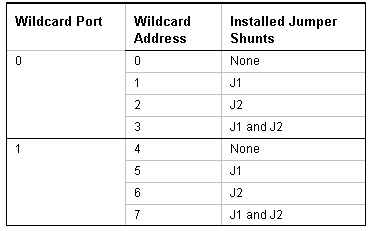


 |
 |
 |
Table of ContentsConnecting To Mosaic Controller RS422/485 Configuration Jumpers Protocol Configuration and Direction Control Registers Overview of the Software Device Driver Functions Installing the UART Module Driver Software Using the Driver Code with Forth UART Direction Control in a Multitasking System C Demonstration Program (in pdf) |
UART Wildcard User GuideUART Wildcard HardwareThe UART Wildcard comprises a Wildcard bus header, field header, digital logic circuitry, a dual UART chip, and driver/receiver circuitry for the RS232, RS422, and RS485 protocols. Jumpers enable module address selection, conversion from RS422 to RS485, and the installation of optional RS422/485 termination networks. The Wildcard bus header interfaces to the host processor (QCard, QScreen, Handheld, or PDQ series controller), and the field header brings out the serial I/O signals for the two serial channels. Connecting To the Wildcard BusTo connect the UART Wildcard to the Wildcard bus on the controller board: With the power off, connect the female 24-pin side of the stacking go-through Wildcard bus header on the bottom of the UART Wildcard to Wildcard Port 0 or Wildcard Port 1 on the controller or its mating PowerDock. The corner mounting holes on the Wildcard should line up with the standoffs on the controller board. The Wildcard ports are labeled on the silkscreen of the controller board. Note that the UART Wildcard headers are configured to allow direct stacking onto the controller board, even if other Wildcards are also installed. Do not use ribbon cables to connect the UART Wildcard to the Wildcard bus. Use of ribbon cables on the UART Wildcard’s field header is fine. CAUTION: The Wildcard bus does not have keyed connectors. Be sure to insert the module so that all pins are connected. The Wildcard bus and the UART Wildcard can be permanently damaged if the connection is done incorrectly. Selecting the Wildcard AddressOnce you have connected the UART Wildcard to the Wildcard bus, you must set the address of the module using jumper shunts across J1 and J2. The Wildcard Select Jumpers, labeled J1 and J2, select a 2-bit code that sets a unique address on the Wildcard port of the controller board. Each Wildcard port on the controller accommodates up to 4 Wildcards. Wildcard Port 0 provides access to Wildcards 0-3 while Wildcard Port 1 provides access to Wildcards 4-7. Two Wildcards on the same port cannot have the same address (jumper settings). Table 1-1 shows the possible jumper settings and the corresponding addresses. Table 1-1 Jumper Settings and Associated Addresses  |
Home|Site Map|Products|Manuals|Resources|Order|About Us
Copyright (c) 2006 Mosaic Industries, Inc.
Your source for single board computers, embedded controllers, and operator interfaces for instruments and automation